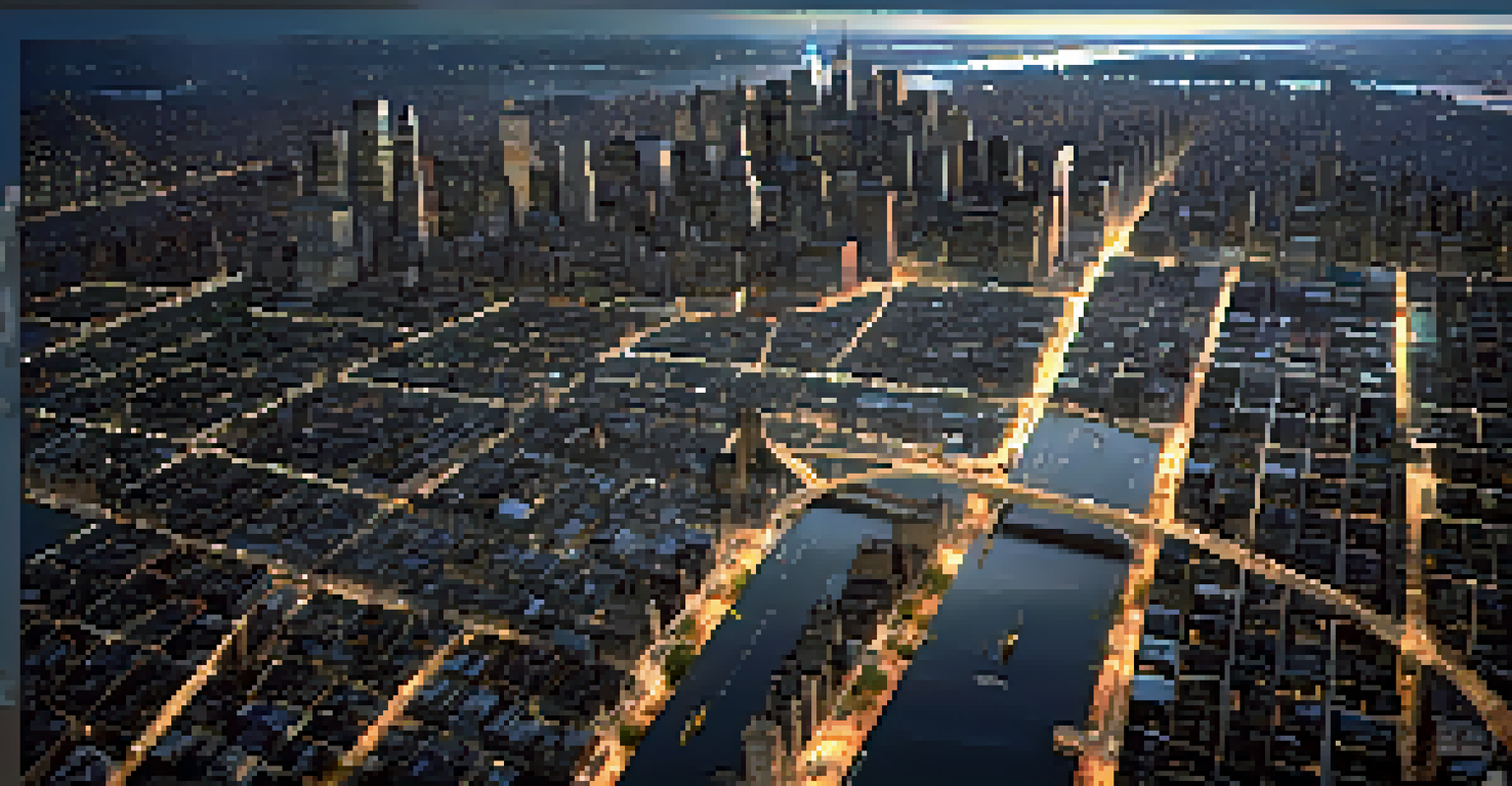Climate Change Effects on NYC's Weather Patterns

Understanding Climate Change and Its Relevance to NYC
Climate change refers to long-term shifts in temperatures and weather patterns, primarily driven by human activities such as burning fossil fuels. For cities like New York, understanding these changes is crucial as they directly affect urban life. The impacts are not just environmental; they intertwine with social and economic issues, making climate awareness a city-wide priority.
Climate change is not just an environmental issue; it's a social justice issue, and it will affect our economy and our health.
In NYC, the effects of climate change are becoming increasingly evident, with rising sea levels and more frequent extreme weather events. For instance, the city faced significant flooding during Hurricane Sandy in 2012, which highlighted its vulnerability. These incidents serve as stark reminders of what the future may hold if climate action is not prioritized.
By recognizing the relevance of climate change, New Yorkers can better prepare for the challenges ahead. Public awareness and education about sustainable practices are essential. This understanding lays the groundwork for more informed decisions that can lead to a more resilient city.
Rising Temperatures and Heat Waves in NYC
One of the most noticeable effects of climate change in New York City is the rise in average temperatures. Over the past century, NYC has experienced an increase of approximately 4°F, which might sound minor but has significant implications. Higher temperatures often lead to more frequent and intense heat waves, impacting public health and energy consumption.

During these heat waves, vulnerable populations, such as the elderly, face higher risks of heat-related illnesses. Moreover, the surge in energy demand for air conditioning can strain the power grid, leading to outages. This creates a cycle of vulnerability, where those least equipped to cope are hit hardest.
Climate Change Threatens NYC's Future
New York City faces significant risks from climate change, including rising sea levels, increased flooding, and extreme weather events.
To combat rising temperatures, initiatives like increasing green spaces and promoting urban forestry can help mitigate heat effects. Community awareness and participation in these initiatives are vital. Such measures not only improve air quality but also provide relief from the sweltering heat.
Increased Rainfall and Flooding Risks
Climate change is also causing increased rainfall, leading to a higher risk of flooding in NYC. The city has seen a trend of heavier downpours, which can overwhelm drainage systems designed for less intense storms. Consequently, urban flooding has become a more common occurrence, disrupting daily life and damaging infrastructure.
The Earth has a fever. The fever is rising, and we know what the cure is: a transition to clean energy.
These floods not only affect homes and businesses but also pose serious threats to public safety. Streets can become impassable, and essential services may be interrupted. For instance, the heavy rains associated with storms can lead to significant disruptions in public transport, affecting commuters and residents alike.
To address these challenges, NYC is investing in green infrastructure, such as permeable pavements and rain gardens, to help absorb excess rainfall. These solutions not only mitigate flooding but also enhance the city’s aesthetic appeal. Collaboration between city planners and residents is key to developing effective strategies for managing increased rainfall.
The Impact of Sea Level Rise on Coastal Areas
Sea level rise is one of the most alarming effects of climate change, particularly for coastal cities like New York. The city’s proximity to the Atlantic Ocean makes it vulnerable to rising sea levels, which threaten infrastructure and ecosystems. According to scientists, sea levels around NYC could rise by as much as 6 feet by the end of the century, depending on global greenhouse gas emissions.
This rise puts low-lying neighborhoods at significant risk of erosion and flooding, potentially displacing residents and businesses. Areas like Lower Manhattan and parts of Brooklyn are already seeing the effects, which can lead to costly repairs and loss of property. The prospect of losing vital cultural and historical landmarks adds an emotional weight to these concerns.
Community Action Builds Resilience
Engaging local communities in sustainability initiatives and disaster preparedness can help New Yorkers adapt to climate challenges.
To combat this threat, NYC is implementing coastal resiliency projects that include building sea walls and restoring natural barriers like wetlands. These efforts aim to protect vulnerable communities while also preserving the city’s unique character. Engaging local communities in these projects fosters a sense of ownership and responsibility toward the environment.
Changing Ecosystems and Biodiversity in NYC
As climate change alters weather patterns, New York City's ecosystems are also undergoing significant changes. Warmer temperatures and shifting precipitation patterns can disrupt the habitats of various species, leading to a decline in biodiversity. Native plants and animals may struggle to adapt to these rapid changes, while invasive species may thrive in the new conditions.
For instance, species like the Eastern Oyster, once abundant in New York waters, have faced challenges due to pollution and changing temperatures. Loss of biodiversity can have far-reaching effects, including the destabilization of food chains and ecosystem services that cities depend on, such as clean air and water.
To support local ecosystems, initiatives like community gardens and urban wildlife habitats are gaining traction. These projects not only encourage biodiversity but also foster a deeper connection between residents and their environment. Educating the public about the importance of preserving local flora and fauna is essential for building a sustainable future.
The Economic Impacts of Climate Change on NYC
Climate change poses significant economic challenges for New York City, affecting industries from tourism to real estate. Extreme weather events can lead to costly damages, while rising sea levels threaten coastal properties, impacting property values. These economic risks aren’t just theoretical; they have real consequences for residents and businesses alike.
Insurance companies are beginning to adjust their policies to account for increased risks associated with climate change, which can lead to higher premiums for homeowners and businesses. Additionally, the financial burden of repairing infrastructure after severe weather events can strain city budgets and divert funds from other essential services.
Economic Impacts of Climate Change
Climate change poses economic risks for NYC, affecting property values and increasing insurance costs due to extreme weather events.
To mitigate these economic impacts, NYC is focusing on sustainability initiatives that promote green jobs and renewable energy. Transitioning to a more sustainable economy not only helps combat climate change but also positions the city as a leader in innovation. Community involvement in these initiatives can further bolster economic resilience.
Community Resilience and Adaptation Strategies
Building community resilience is crucial in the face of climate change's impacts on NYC. Community-based organizations play a vital role in preparing residents for extreme weather events and fostering a culture of sustainability. By engaging locals in discussions about climate adaptation, these organizations help empower communities to take action.
Adaptation strategies can range from improving public infrastructure to implementing emergency response plans. For example, neighborhood groups can organize training sessions on disaster preparedness, ensuring that residents know how to respond during emergencies. Such proactive measures not only enhance safety but also strengthen community bonds.

Additionally, fostering a culture of sustainability through education and advocacy can inspire individuals to make eco-friendly choices. From reducing waste to supporting local businesses, every small action contributes to a larger movement. Together, communities can create a resilient future that prioritizes both people and the planet.